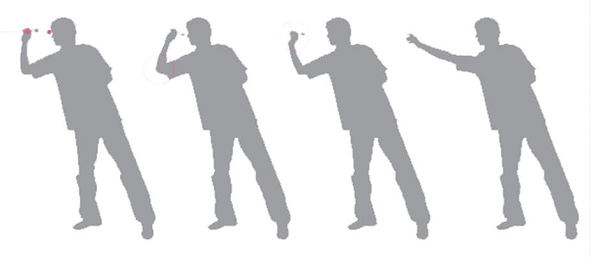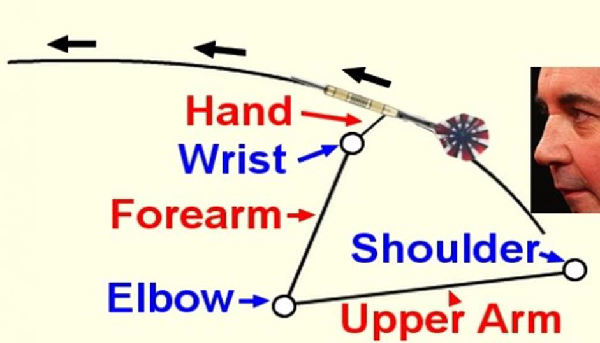Darts – How to play?
Knowledge of Recipe doesn’t make a good chef, instead the art of cooking does. Similarly if you know only the scoring methods, then it does not mean you can play well. It requires the techniques and arts of holding, throwing and manipulating the darts so that it will hit the target. Let’s learn about some basic things about the game.
Standing Posture
People often neglect about the standing posture but it is the first thing that is going to set the base of your winning chance. Always draw an imaginary line from the bull’s eye of the dart towards your line of throwing. Mark it over there with a color. Make sure that you always start throwing your dart from that position only.
Stand with such a posture that there will be a shoulder’s apart distance between your two feet. The front foot should bear more weight of your body than the back foot. This improves balance and accuracy but too much leaning forward may cause back injuries. So the player is always advised to find his perfect balance spot by rigorous practice.

The position of your arm should be parallel to the ground. Sometimes it varies between 50-90 degrees varying from person to person but the shoulders should stay fixed with respect to other parts of the body.
Gripping Techniques
There is no hard and fast rule about the gripping techniques in dart. The gripping depends upon the two things −
- The barrel of the dart.
- The finger positioning that makes you comfortable.
Other things to be considered are given below −

-
The tip of your dart should always face up.
-
The grip should not be so tight that it will make your dart face downward as it will hamper your accuracy.
-
Your eye should make a straight line between the tip of the dart and your aim before releasing it.
-
While holding the dart you should not make your grip too tight or too loose.
-
A relaxing and firm grip is needed. You should hold the dart as if it is a potato chip.
-
Do not press it hard before releasing.
-
It is a bad practice to keep your free fingers very close to the dart.
-
If your free fingers are up in the air, then it reduces the muscle strains on the other fingers.
-
It is always necessary to find the center of gravity of the dart.
-
For that you have to place the dart on your palm and with your non-throwing hand slide it towards your fingers to hold it.
-
Make sure you don’t touch the flight or the shaft of the dart.
Throwing Techniques
The art of throwing is the most important aspect in this whole game. Yet most people underestimate this. Without giving a close analysis people throw the darts like throwing stones into the river. Some people lean forward, some go back and forth, some even throw quickly without giving a second thought. Everyone’s style is unique. Still we should know the basics of it because once your basic is strong it will act as a base upon which you can build the house of techniques of your own that gives you best result.
-
Alignment is the most important thing 1st you should align in such a manner that your hands, shoulders and elbow remains in a straight line.
-
Movement of your elbows to much left or right may cause mechanical imbalance. So don’t do much deviation.
-
However; a small variation of elbows may be used depending upon the personal preferences.
Your throwing should be just like swinging a hammer. Use your shoulder for a farm support and use your wrist and hand to boost his speed. While extending your arm makes sure your elbow goes to the optimum height to give necessary kinetic force to the dart. A clear illustrating picture is given below.

At the beginning of the throw it is advisable to hold the dart sideways maintaining the right level. Leaning and swaying is not a good idea. It makes your target not only small but also movable which in turn makes it difficult for you to hit the required target. Seems like, we have gathered some basic knowledge upon throwing darts. Now let’s learn some techniques about aiming.
Aiming Techniques
A successful throw depends upon many factors and a good aim tops that list. Aiming has different techniques. Some people use line of sight method which is proved to be helpful in many cases. In this method you can aim the target with either any of the following −
- The first or second knuckle of your throwing hand’s thumb
- The tip of the dart
- Small finger of the throwing hand
Some people try to aim the target with either right or left eye but this is indeed a lazy practice.
Another best thing that is often advised is to identify your dominant eye. The process of identifying your dominant eye is quite simple. Try to throw the darts at the board by closing each of your eyes separately. Use the eye which you feel difficult to close to get the best results.
Practice Guidelines
The golden lines Practice makes perfect
does apply here also like any other sport. Rather focusing upon practicing for long hours it is good to focus upon the schedule and techniques.
Play your every move as if you are fighting for the final title in a tournament. Always set a particular goal every day. Once you achieve that goal or target, move on to next one without wasting much time on practicing it further because it is the quality that matters not quantity.
Scoring
The whole dart board has been divided in to 20 sections, with points ranging from 1 to 20. Single, double and triple areas are again symbolized within the darts with the help of wires. The darts hitting the corresponding semi-circle decides whether the corresponding point is to be treated as single or double or tripled. The maximum possible highest score that one can obtain here is 180 by hitting the 20 point in the triple semicircle region, known as ton-eighty.
